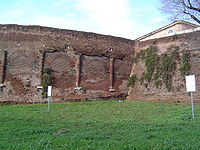
Amphitheatrum Castrense
Encyclopedia

Roman Empire
The Roman Empire was the post-Republican period of the ancient Roman civilization, characterised by an autocratic form of government and large territorial holdings in Europe and around the Mediterranean....
amphitheatre
Amphitheatre
An amphitheatre is an open-air venue used for entertainment and performances.There are two similar, but distinct, types of structure for which the word "amphitheatre" is used: Ancient Roman amphitheatres were large central performance spaces surrounded by ascending seating, and were commonly used...
in Rome
Rome
Rome is the capital of Italy and the country's largest and most populated city and comune, with over 2.7 million residents in . The city is located in the central-western portion of the Italian Peninsula, on the Tiber River within the Lazio region of Italy.Rome's history spans two and a half...
, next to the church of Santa Croce in Gerusalemme
Santa Croce in Gerusalemme
The Basilica of the Holy Cross in Jerusalem is a Roman Catholic parish church and minor basilica in Rome, Italy. It is one of the Seven Pilgrim Churches of Rome....
. It is the second ancient amphitheatre of Rome after the Colosseum
Colosseum
The Colosseum, or the Coliseum, originally the Flavian Amphitheatre , is an elliptical amphitheatre in the centre of the city of Rome, Italy, the largest ever built in the Roman Empire...
.
History
The amphitheatre is dated to the first decades of the 3rd century AD by the style of the bricks and the absence of brick stamps. It was part of an Imperial villa complex which was built by emperors of the Severan dynastySeveran dynasty
The Severan dynasty was a Roman imperial dynasty, which ruled the Roman Empire between 193 and 235. The dynasty was founded by the Roman general Septimius Severus, who rose to power during the civil war of 193, known as the Year of the Five Emperors....
. The open arches of the outer walls were walled up when the building was incorporated into the Aurelian Walls
Aurelian Walls
The Aurelian Walls is a line of city walls built between 271 and 275 in Rome, Italy, during the reign of the Roman Emperors Aurelian and Probus....
(271-275 AD) and the ground level around the building was lowered. In the middle of the 16th century the remains of the second story were demolished for defensive needs. Palladio and Étienne Dupérac
Étienne Dupérac
Étienne Dupérac was a French painter, draughtsman and engraver, and a topographer and antiquary, who arrived in Rome in 1559...
made drawings about the ruins.
Construction
The building is a regular ellipse 88 meters long and 75.80 meters wide. It is unusual for being built of brickBrick
A brick is a block of ceramic material used in masonry construction, usually laid using various kinds of mortar. It has been regarded as one of the longest lasting and strongest building materials used throughout history.-History:...
, rather than the more usual stone, except for a few decorative elements in travertine
Travertine
Travertine is a form of limestone deposited by mineral springs, especially hot springs. Travertine often has a fibrous or concentric appearance and exists in white, tan, and cream-colored varieties. It is formed by a process of rapid precipitation of calcium carbonate, often at the mouth of a hot...
. The structure was three stories high but only a section of the lowest story is preserved.

